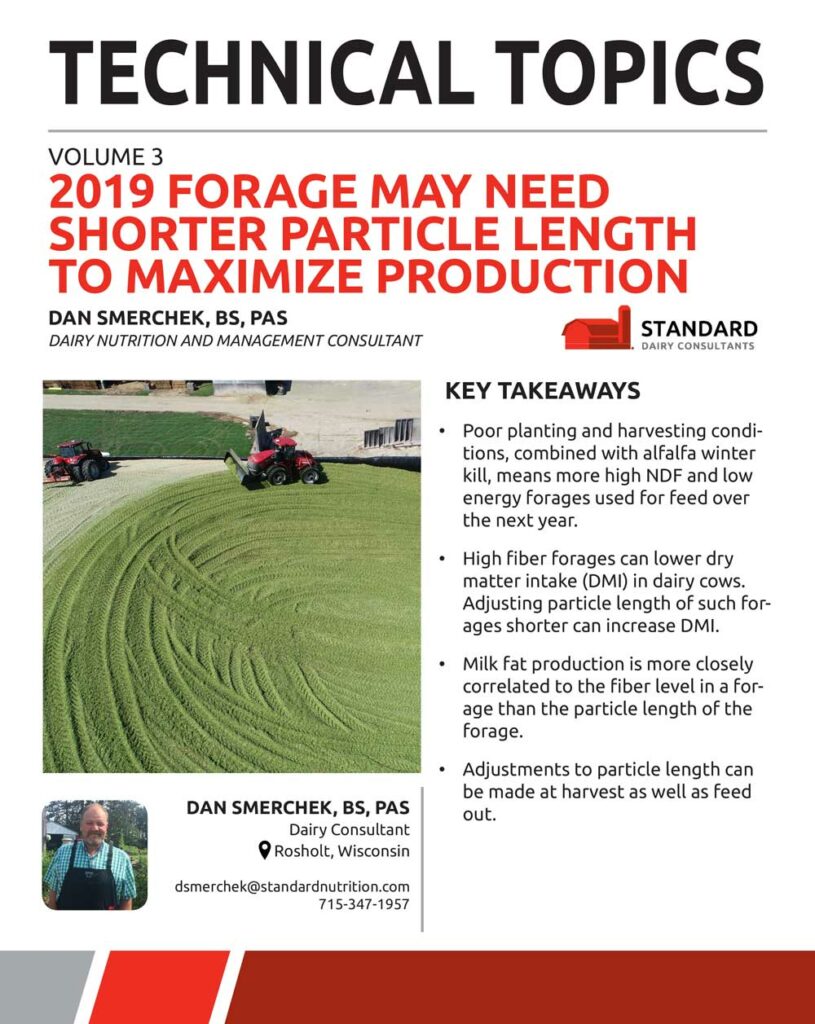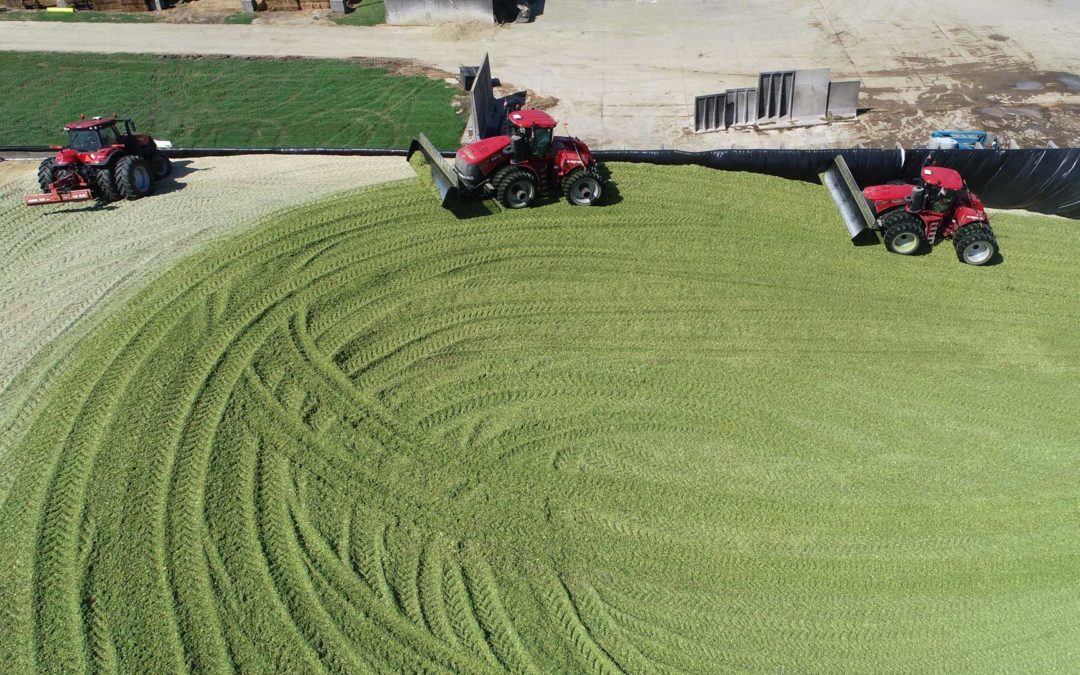Written by: Dan Smerchek, BS, PAS
KEY TAKEAWAYS IN THIS ISSUE OF TECHNICAL TOPICS:
- Poor planting and harvesting conditions, combined with alfalfa winter kill, mean more high NDF and low energy forages used for feed over the next year.
- High fiber forages can lower dry matter intake (DMI) in dairy cows. Adjusting the particle length of such forages shorter can increase DMI.
- Milk fat production is more closely correlated to the fiber level in a forage than the particle length of the forage.
- Adjustments to particle length can be made at harvest as well as feed out.

MORE HIGH NDF FORAGES IN 2019
High-quality forages play a significant role in a profitable dairy operation. Understandably, proper production and storage of high-quality forage are two of the most difficult challenges a dairy management team faces on a year-to-year basis. There are several processing and handling factors that affect the quality of the forage we make available to the dairy herd. Dairy management teams focus a lot of effort on the aspects of harvest, storage, and feed out that can help improve the performance and profitability of the dairy operation. It appears the 2019 crop year will prove to be another challenging forage harvesting season. I want to address some new research that indicates that monitoring the length of cuts can help increase production and performance on lower-quality forages.
2019 alfalfa winter kill was substantial and is one of the worst winter losses in recent history. Due to the significant loss of the alfalfa crop, dairy producers are left to choose from several different crop varieties to replace alfalfa, many of which would be considered lower quality from an energy and fiber standpoint. Challenging harvest windows may leave a larger than normal percentage of 2019 forage as a high fiber lower energy feedstuff (high uNDF240). The dairy industry has long understood that higher uNDF feeds negatively impact dry matter intake. The question is: What can producers do to reduce the negative impacts on intake and ultimately improve performance?
NEW RESEARCH FROM THE MINOR INSTITUTE
Dairy owners and managers, as well as dairy nutritionists, have worked on adding particle size length to TMRs for decades. The dairy industry has perfected practices to add length to TMRs to ensure a healthy rumen environment and improve feed efficiency. Contrary to long-standing dairy forage feeding practices, recent research at the Miner Institute would challenge what we think we know about the optimum physical length of a dairy TMR. Of course, forage quality needs to be considered as part of the equation when determining the proper length of forages in a dairy diet. The Miner Institute research showed that cows fed high uNDF (low energy) diets had a higher dry matter intake when forage was chopped or processed to a shorter particle length. Cows spent more time eating and more time ruminating on the longer-cut, lower-quality forages, but the final particle length the cow presents to the rumen is the same. They have an amazing ability to present a consistent particle length to the rumen for fermentation and digestion. It is important to note that this was observed with lower-quality forages. Highly digestible forage, BMR, and some high-cut silages can still be cut at longer lengths as the digestion of the forages are quite adequate by their nature.
EFFECTS ON COMPONENTS
In today’s component-driven milk market, shortening the physically effective fiber (peNDF) in a TMR may seem to be counterproductive given the assumed benefits of longer particle size and extended duration of fermentation. Research at the Miner Institute showed that milk fat production was more strongly correlated to uNDF240 in the diet than the peNDF level. They also observed that eating time was reduced as particle length was reduced. Reduced time at the feedbunk is something that could be of importance to dairy managers who over-crowd bunk space. Measurements of ruminal pH followed a similar trend in that optimum rumen pH was more strongly associated with high uNDF240 rather than peNDF (i.e. particle length). Rumen pH is an important factor when considering fermentation and utilization of forages in a dairy diet. Fermentation is a key component of how well a forage will feed out, and shortening its length at harvest will almost always enhance the process of fermentation.
OPTIONS TO ADJUST PARTICLE LENGTH
The length of chop on forages can be managed at harvest by adjusting harvesting equipment. Physically effective NDF can also be adjusted at feed out with processing equipment, increasing mixing time, or adding knives to the TMR mixer.
The next question may be: Is forage length important in a dairy TMR? The answer is still yes! It is still very important that we measure and keep forage particle length in mind in a dairy TMR for all reasons we have in the past, such as maintaining feed efficiency and a proper rumen environment with high-quality forages. The research from the Miner Institute indicates producers can or should consider particle length if certain low energy, high fiber forages need to be utilized in the diet.
In summary, energy is one of the most expensive and important components of a dairy diet. Shortening the length of chop on lower energy forages will help increase the energy available to the cow. We should take care to understand the proper length to harvest forages to help increase profitability and efficiency on the dairy, especially in a year when high-quality forages may be hard to come by.
NEW FRONTIERS IN METRITIS TREATMENT
Written by: Chad Jenkins, MS
The length of chop on forages can be managed at harvest by adjusting harvesting equipment. Physically effective NDF can also be adjusted at feed out with processing equipment, increasing mixing time, or adding knives to the TMR mixer. The next question may be: Is forage length important in a dairy TMR? The answer is still yes! It is still very important that we measure and keep forage particle length in mind in a dairy TMR for all reasons we have in the past, such as maintaining feed efficiency and a proper rumen environment with high-quality forages. The research from the Miner Institute indicates producers can or should consider particle length if certain low energy, high fiber forages need to be utilized in the diet. In summary, energy is one of the most expensive and important components of a dairy diet. Shortening the length of chop on lower energy forages will help increase the energy available to the cow. We should take care to understand the proper length to harvest forages to help increase profitability and efficiency on the dairy, especially in a year when high-quality forages may be hard to come by.
IMPROVED COMPONENT PRICING SPELLS OPPORTUNITY
Written by: Dan Illg, PhD
Milk fat and milk protein values have changed dramatically in recent months. Federal Milk Market Order price paid for milk fat and milk protein has increased from $2.50 and $1.19 per pound, respectively in January to $2.66 and $2.44 per pound, respectively in August. What does this mean to dairy producers? A herd averaging 85 pounds of milk with 3.75% Fat and 3.00% Protein would have been paid $12.41 per cow per day in January and $15.67 per cow per day in August. This alone is a bright spot for dairy producers.
Another consideration for dairy producers is the ability to invest in some technology to alter milk components that will offer a return on investment. The two technologies that come to mind are high palm fat sources and amino acid balancing of rations.
Regarding the high palm fat sources, the benefit of increasing the butterfat in the milk by 0.15% moves the income from $15.67 per head per day to $16.01 per head per day or $0.34 per head per day. In January, the difference would have been $12.41 per head per day compared to $12.73 for a difference of $0.32 per head per day. Does the cost of feeding the high palm fat product allow a return on investment? The value of butterfat has improved some and consequently, there is a slight benefit to increasing butterfat in August compared to pay prices in January.
Regarding amino acid nutrition, whether the amino acids are coming from single protected amino acid sources or from protein sources that provide the protected amino acids by treatment or the physical nature of the protein, the same return on investment question comes into play. If a ration implemented can improve the protein concentration in the milk by 0.15%, the value of the 85 pounds of milk increased from $15.67 to $15.99 per head per day or $0.31 per head per day in the August market compared with $12.41 to $12.56 per head per day or $0.15 per head per day in January. With amino acid balancing, there is a potential for more milk production and perhaps butterfat which would add value to the technology. Based on protein alone, it may sensible to justify the amino acid technology as the return on investment becomes a multiple of the January time period.
This comparison shows the influence of the price of components on decisions that can be made by dairy producers and their advisors. When market conditions support the use of technologies, there is a sound basis for using them to improve the profits of the dairy. Many of these technologies have other benefits which are more difficult to measure. When the milk value makes sense, the technology makes sense. The other benefits become a bonus.


